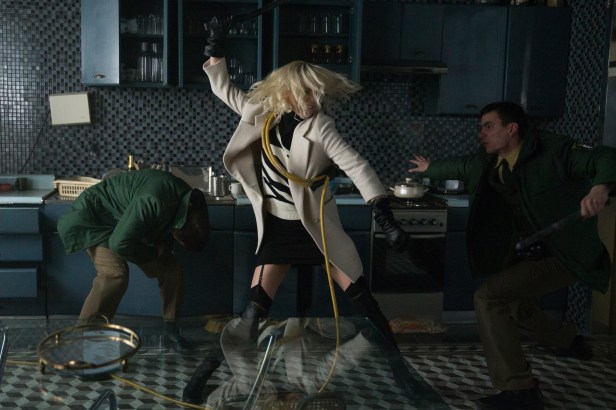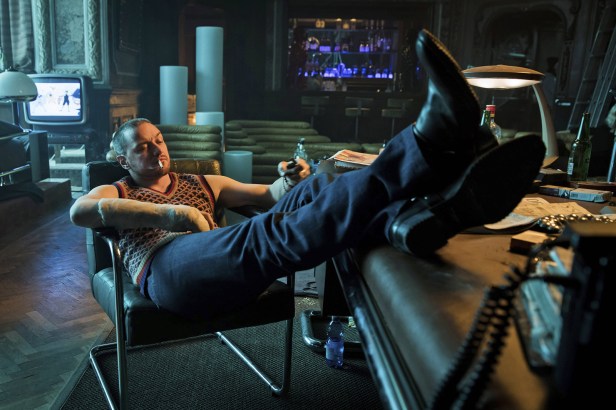Atomic Blonde (2017)
I’ve always been an advocate of female empowerment; watching sexy, confident women kick-ass (on the big screen or anywhere else, for that matter) is something I wholeheartedly enjoy. Those who know me (well) know that I’ve been screaming to see a female-led superhero film ever since Tobey Maguire donned the Spidey suit all the way back in 2002 — thank you Patty Jenkins. Moreover, I grew up worshiping the American comic book Danger Girl, created by J. Scott Campbell and Andy Hartnell, the series following a troop of flamin’ female secret agents — think 007 meets Indiana Jones — whose fierce and fiery international escapades, if adapted correctly, would make one heck of an explosively hot action-thriller. Thus, it pains me to report that Atomic Blonde, while starring the sensual Charlize Theron as an elite, peroxide-haired MI6 spy, is a bit of a letdown, this Lethally Blonde Bond film a textbook example of ‘all style and no substance;’ given its hard-R rating and skilled action filmmaker behind the lens, Atomic Blonde really should have been better.

Based on the Oni Press 2012 graphic novel series titled The Coldest City — penned by Antony Johnston and illustrated by Sam Hart — Atomic Blonde follows the strong and seductive Lorraine Broughton (Charlize Theron), a top-level covert agent working for Her Majesty’s Secret Intelligence Service. Set in East and West Germany in the winter of 1989, a time of great political unrest, we trail agent Broughton as she is dispatched, alone and undercover, into the damaged and divided Berlin city just days before the collapse of the Berlin Wall, our ‘hell in heels’ heroine tasked with retrieving a stolen list, this dossier (a tiny microfilm concealed in a wristwatch) containing the names of all the Western field operatives currently active in the Soviet Union — because, what person would be stupid enough to compile such an exhaustive ‘Secret Agent’ compendium? What would be its purpose other than to expose everyone’s identity?
Anyhow, within minutes of touching down in Germany, Broughton is greeted by the KGB, who ambush her as she’s leaving the airport. Narrowly escaping with her life, the death-dealing dame rendezvous with her ‘contact,’ shady MI6 station chief David Percival (James McAvoy), who shows up just in the nick of time, the unhinged informer coming to Lorraine’s aid during the attempted on-road hit. Now, under strict instructions from their superiors, the major-league super-spies are compelled to work together — even if our leading lady can trust the dubious David about as far as she can throw him. And so, with just a few days to reclaim the file, Broughton is forced to unleash her arsenal of killer skills and instincts; well, that’s if she plans on completing the job and making it out of the country alive.

Sound relatively straightforward? Well, things get a lot more complicated. Written by Kurt Johnstad, 300 (2006), Atomic Blonde takes a somewhat simple premise (two agents racing to recover a priceless ‘document’) then chooses to twist and contort it, the plot far too perplexing for the common moviegoer to grasp — well, at least for the audience that Atomic Blonde is mostly geared towards. True, all good espionage films come with a dab of deception and a hint of betrayal, each character harboring their own hidden agenda, but this Cold War spy caper is just too bloody confusing, the film bound to leave viewers frustrated and baffled — both in equal measure. As the end credits began to roll, I found myself scratching my head, having no idea who had double-crossed whom, character allegiances simply all over the shop! Things just shouldn’t have been this difficult to follow, Atomic Blonde way too convoluted for a beat-em-up.
It doesn’t help that the movie employs a non-linear structure either. You see, the narrative uses a retrospective interrogation as its framing device, Broughton probed by MI6 investigator Eric Gray (Toby Jones) and high-ranking U.S. CIA operative Emmett Kurzfeld (John Goodman), post ‘mission to Berlin,’ this wrap-around more-or-less amounting to nothing; if anything, it tells us that our protagonist will make it out of her ordeal alive. We’re given copious shots of Broughton’s angry superior, Mr. Gray, and the gruff Kurzfeld as they grill the bruised and banged-up babe following her failed assignment, the big-wigs throwing allegations left, right and center; but with many of these accusations and name-drops being too hard to decipher (on first sitting anyway), the scenes hold minimal weight or impact.

Furthermore, there’s all this stuff about the KGB and the East vs West Berlin conflict that’s bound to shoot over the heads of most, along with the assassination of a mustached undercover man, James Gasciogne (played by the flick’s stunt/ second unit director, Sam Hargrave), whose relationship with Broughton is never made clear (or fleshed out properly), Gasciogne part of a subplot concerning the identity of a mole known simply as Satchel, a double-agent who’d allegedly been selling Intel to the Russians for years. Confused? I sure was! Look, what we’re ultimately left with is a messily plotted picture populated by one-note characters that we care very little about. But, hey, it’s easy on the eyes.
Packing one helluva punch, aesthetically, Atomic Blonde excels in its look and design, the film steered by stunt coordinator-turned-filmmaker David Leitch, who co-directed 2014’s excellent John Wick. Shifting from the drab and muted streets of London to a glossy, neon-noir Berlin, Atomic Blonde is flash as f-ck, the retina-searing visuals by cinematographer Jonathan Sela, Transformers: The Last Knight (2017), complementing the hyper-violent action, the imagery very much reminiscent of ’80s punk subculture, as well as Blonde’s comic book origins. Energizing proceedings moreso is the pulsating score by Tyler Bates, Guardians of the Galaxy (2014). And let’s just take a moment to admire the 1980s soundtrack. Featuring New Wave pop icons such as David Bowie, The Clash and George Michael, Atomic Blonde’s era-appropriate beats are viciously electric — just like our fatal femme fatale — the tunes cool enough to rival those of Edgar Wright’s groovy Baby Driver (2017). Honestly, it was sweet nostalgic bliss to hear Re-Flex’s ‘The Politics of Dancing’ blare through the theater’s 7.1 surround sound.

To be blunt, though, the highly stylized scuffles are what really fuel the film, these tightly choreographed beat-downs a brutal blend of mixed martial arts and frenzied gun-play, Atomic Blonde constructed around a number of visceral and uncompromising action set pieces, these charged further by the surrounding Cold War crisis. The film’s centerpiece is a blood-soaked confrontation that starts out in an apartment and stairwell before moving out onto the street, this immersive fight scene appearing to be captured in one unbroken take. Here’s a sequence so gripping that it’s bound to have patrons affixed to their seats, anticipating that inevitable ‘cut’ to catch a breath — one can almost feel the punches connect, along with the bangs and bullet fire. Provocative stuff! If only the story were this enthralling.
Performances are solid all around, despite there being next to no insight into any of the characters — so, why should we care about them? Charlize Theron, Mad Max: Fury Road (2015), owns the role of Lorraine Broughton, a sizzling, lingerie-clad Furiosa with lesbian tendencies, the 42-year-old bombshell proving that she has what it takes to be a modern-day action star, our bone-crunching terminatrix busting up anyone who crosses her path; be it opening a can of whoop-ass on various attackers in closed quarters or fending off a bunch of coppers with regular household items — this woman is a bona fide weapon!

Sporting a Sinéad O’Connor hair-do, the always reliable James McAvoy, Split (2016), is magnetic as the deadly, self-destructive David Percival, whilst John Goodman, 10 Cloverfield Lane (2016), is, well, John Goodman, and the guy hardly disappoints. Elsewhere, Sofia Boutella, The Mummy (2017), is wasted as sultry French intelligence agent Delphine Lasalle, the dancer-turned-actress merely used to steam up the screen in multiple girl-on-girl ‘bedroom’ scenes — given Boutella’s background in gymnastics, filmmakers could’ve surely done more with the character, action-wise. And, oh, Eddie Marsan, Sherlock Holmes (2009), has a small part to play as a dude code-named Spyglass, whose back-story is hardly unpacked, this guy (who’s in possession of the covert file) betraying his government in exchange for relocation into West Berlin.
A pulpy, jazzy-lensed spy romp, Atomic Blonde should’ve been able to match the butt-kicking heights of Keanu Reeves’ gun-fu spectacular John Wick (at a minimum); but John Wick this film is not. While certainly hitting all the right targets in the technical department, Atomic Blonde, as a package, is far too incomprehensible, the movie’s distinct flavor and the supernova star-power of Charlize Theron pushing it into watchable territory. A John Wick and Lorraine Broughton mash-up, though; now there’s an idea worth smiling about!
3 / 5 – Good
Reviewed by S-Littner
Atomic Blonde is released through Universal Pictures Australia
I missed this in cinema but may get it on DVD. Good review.